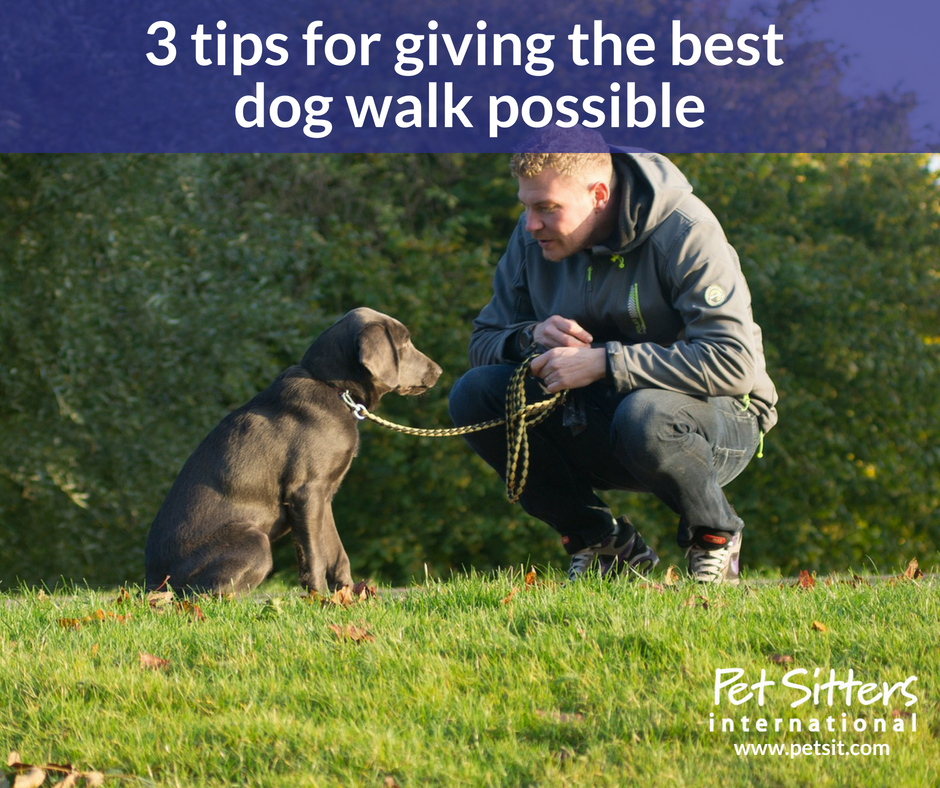3 tips for giving the best dog walk possible
Setting yourself apart from other dog-walking professionals can be a challenge. One of the most fundamental ways to distinguish your service is to offer the dogs in your care the best walk possible. That means providing for all of a dog’s mental and behavioral needs. With a little extra effort, you can delight the dogs and instill good walking behavior. This will benefit the owners and ultimately boost your business.
Whether a walk is a success should be based on the dog’s point of view. In that case, the number of blocks covered or the cost per hour won’t factor in. A dog is not just looking for a workout; he is also looking for mental stimulation and the freedom to express his natural instincts.

Here are three tips that will help you give your dogs the best walk possible.
Tip #1: Embrace sniff and explore time.
Unlike humans who are mostly visual, dogs experience the world through their noses. Their sense of smell is at least 10,000 times more powerful than ours due to millions more scent receptors in their noses and a proportionately much larger part of their brains dedicated to analyzing smells. Their noses also have a special organ that allows them to perceive chemical signals that would otherwise be undetectable. It’s almost impossible to imagine the amount of information dogs can discover with one sniff.
Just as you might want to look at the scenery on a walk, a dog will want to smell all that the environment has to offer. He can learn about other dogs in the neighborhood, track squirrels, and find the best places to eliminate. Having him heel for the entire walk or pulling him away from every hydrant is like having to return a gripping mystery novel to the library before you find out whodunit. Allowing a dog time to sniff and explore prevents frustration and boredom, makes the walk an enriching experience, and provides important mental exercise, which can be just as exhausting as the physical kind.
But your whole walk shouldn’t be spent at a single shrub. Consider giving the dog a chance to explore as a reward for a short burst of loose leash walking or heeling. This will ensure a balanced walk. Meeting all the dog’s needs and teaching him that walking nicely pays off will make future walks easier. Ask your clients if they have taught a “leave it” or “watch” cue. This can help the dog shift his focus from whatever he’s exploring back to you, so you can move him along to the next interesting smell.
Tip #2: Don’t rush bathroom breaks.
Dog bathroom behavior is not just about eliminating waste, it’s about communication too. Dogs use urine as a calling card, letting the world know where they have been. In turn, smelling the urine left by other dogs tells them about their canine community. Thanks to that amazing sense of smell, a dog can determine details like the sex, age, and health of his neighbors. Sometimes called pee-mail, this is like social media for dogs. Where you might check your phone for the latest post, a dog wants to check the popular pee spots to keep up on the local gossip.
This is another reason to allow dogs plenty of time to sniff and explore during a walk. Going to the bathroom means more than looking for a bare patch of grass. Finding the perfect spot is essential for gathering information and adding their own deposit to the conversation. Some dogs also like to scratch the ground with their feet to emphasize their message. All this sniffing and scratching takes time and concentration.
Ask your clients if their dogs have learned a potty cue such as “do your business.” If they have, you can use it to let the dogs know exactly where and when you would like them to go. Having them eliminate at the beginning of the walk or in a certain area can be very convenient. To teach a potty cue yourself, watch for signs a dog is about to go then say the cue right before he eliminates and reward him once he’s done. After several repetitions, he will understand what you are asking and will know that if he follows your request he will get a treat or other reward for his trouble.
Tip #3: Keep the leash loose.
You have no doubt noticed that dragging a dog along the sidewalk can be counter-productive. He will either dig in and refuse to move or pull you the other way. He isn’t being stubborn or controlling, he’s simply doing what comes naturally. If you pull on a dog’s leash, he will instinctively pull away in the opposite direction.
Dogs also pull on the leash because humans walk too slowly, and they want to get to the fun stuff, such as an interesting smell or another dog. However, if pulling you along gets a dog where he wants to go, he learns it works. This leads to a leash tug-of-war. The more you allow a dog to drag you, the more ingrained his bad habit will become; the more you drag the dog, the more he will pull back. Unless you rely on equipment like a head halter, you are looking at a struggle every time you walk that dog, not to mention your clients will notice their dog’s walking behavior is not improving.
The recipe for polite leash manners is simple—only let the dog walk when the leash is loose. This might mean standing still when the dog is pulling and only moving forward when he comes back to check on you, letting the leash fall slack; or changing direction every time he gets ahead of you. You can use treats to reward the dog when he turns to catch up or let the chance to walk be its own reward. Your first few walks might be slow and frustrating, but eventually the dog will learn that he only gets to walk when the leash is loose. This will eliminate pressure on the dog’s throat, ease his frustration, and prevent you from triggering a tug-of-war. Your job will become easier and your clients’ dogs will be gaining a valuable new skill.
By providing walks that incorporate these tips, you will be meeting all the needs of the dogs in your care and giving your clients a truly complete service. You will have given their dogs important physical exercise but will also have satisfied their dogs’ mental and behavioral needs. With a little extra effort, you will have contributed to better behavior as well.
Educate your current and potential clients about what their dogs are really looking for when they’re wearing a leash, and how, by enriching their dogs’ walking experience, you offer a service beyond simply taking them around the block. Their dogs will return home both physically and mentally exhausted and delighted by their time out with you. And a happy dog equals a happy owner. Set yourself apart from the competition as a dog walker who does far more than simply walk the dog.

Stephanie Gibeault is a freelance writer and certified professional dog trainer with a master’s degree in animal behavior. A regular contributor to the website of the American Kennel Club, when Stephanie isn’t writing, she’s teaching ever more complicated tricks to her dog and cat.







Comments
Sylvia Gothard
Tharminder
Helene O'Neill
Lisa Castellino
Carly
Sit ___________
Stay __________
Stop pulling _________
Go potty _________
Leave something alone _________
Get something _________
Etc would be so helpful.
Thanks,
Cute Critter Care
CuteCritterCare@yahoo.com